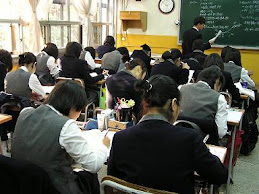Long Le of New America Media, August 2, 2006
HOUSTON, Calif.--In his recent essay “Stellar Academic Achievement Has an Asian Face,” New York Times columnist Nicholas Kristof admired Asian American students’ performance on the SAT. In 2005, Asian Americans had the highest average combined math-verbal SAT, at 1091, compared with 1068 for whites, 982 for American Indians, 922 for Hispanics, and 864 for blacks.
Kristof wonders why this group is so good at school. “Frankly,” he laments, “you sometimes feel at an intellectual disadvantage if your great-grandparents weren’t peasants in an Asian village.”
In explaining Asian Americans as “model students,” Kristof cites Confucianism’s reverence for education with enforcement via filial piety, in which “Asian American kids often manage both to exasperate and to finish their homework,” while non-Asian teenagers rebel.
But before anyone else starts to stress out on not having a Confucian background, there is a “dark side” to Asian American academic achievement that Kristof’s admiration piece veils.
First, non-Asian individuals may indeed perceive Asian American students as exceptional, but some are also likely to interpret how the success of Asian-Americans reflects negatively or positively on their own social position.
For example, Professor Stacey Lee of University of Wisconsin, who studied one particular high school found that high-achieving middle-class white students respect the academic talents of their peers. Some, however, hold up the successes of Asian-Americans to dismiss African-American students’ charges of racial discrimination in America. In addition, she found that low-achieving, working-class white students are more likely to refer to students of Asian descent as “chinks and gooks” who are invading their school. And some African-American students believe that the success of Asian-American students has been achieved at the expense of their own.
According to another study, Asian-American college students say that positive stereotypes that non-Asians have of them focus on educational achievement only. Most of the stereotypes, they say, are negative, such as non-Asians’ perceptions that Asians “don’t speak English well,” “have accents,” and are “submissive,” “sneaky,” “stingy,” “greedy,” etc.
Here, the seemingly positive stereotypes conceal negative stereotypes casting Asian American students as “perpetual foreigners."
As a researcher of Asian American issues, I recently conducted a survey at the University of Houston on campus perceptions of Asian-American and Asian international students, with more than 750 student participants. A preliminary analysis shows that non-Asian students perceive students of Asian descent as “model students” and more often than not as a homogeneous group with more similarities than differences. Non-Asian students also have unfavorable impression of both Asian-American and Asian international students, saying, for example, that students of Asian descent are hard to make friends with.
Moreover, non-Asian students were less likely to prefer a student of Asian descent as a candidate for president of student government relative to other ethnic candidates.
Second, as the stereotype of Asian Americans as “model students” spreads, it may affect how some Asian-American students behave and how they construct their self-identity.
Professor Stacey Lee discovered that some middle class Asian-Americans embrace the “model student” image, perceive their role as having to live up to that image and look down on other Asian groups, particularly those from Southeast Asia, who they believe to be welfare-dependents who give Asians a bad name. Such students, however, tend to mask their feelings of depression and desperation, especially when they don’t meet the stereotype's high expectations. In fact, there has been a recent spike in the number of “unexplained” deaths and suicides among high-achieving students of Asian descent at a number of prestigious universities. Similarly, students of working-class families from Vietnam, Cambodia, and Laos also mask their depression when they feel ashamed about not living up to the “model student” image. They tend to be reluctant to seek academic or emotional support.
In fact, the overall data on Asian American students’ SAT score hides the variation in academic achievement across Asian groups. Southeast Asian students and other student subgroups from South Asia have different standardized test scores, high school dropout rates, college enrollment and completion rates. Their data, in fact, mirror those of African Americans rather than the overall Asian-American numbers.
If the Confucian culture emphasizes and facilitates educational achievement, it may also promote silence on the expression of social and psychological needs.
Source: Le, Long. "The Dark Side of the Asian American 'Model Student'" New America Media. 2 Aug. 2006. 4 Jan. 2008 <http://news.newamericamedia.org/>.
-Alice C.
Subscribe to:
Post Comments (Atom)

No comments:
Post a Comment